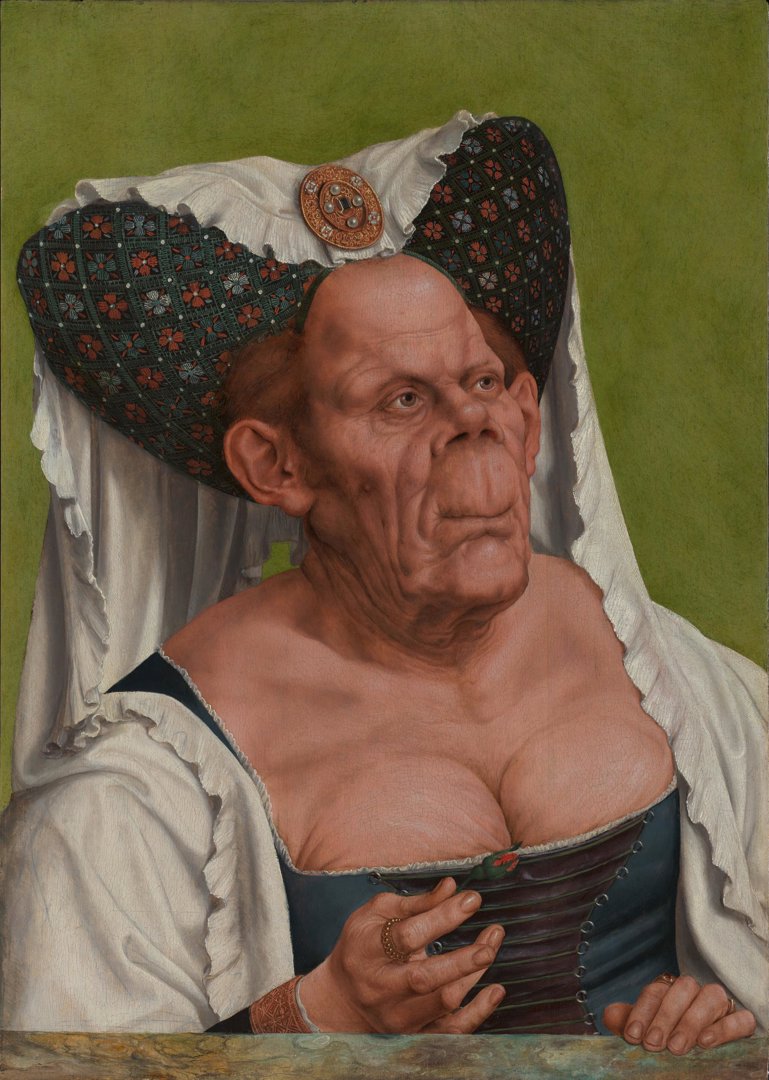An Old Woman, ‘The Ugly Duchess’ reinterpreted and conserved for exhibition on Renaissance Satire
Issued March 2022
16 March – 11 June 2023
Room 46
Admission free
The National Gallery today announced the upcoming exhibition The Ugly Duchess: Beauty and Satire in the Renaissance, opening spring 2023.
It will cast an unexpected light on one of the most famous, but perhaps also most misunderstood, paintings in the Gallery’s collection, An Old Woman (about 1513) by Quinten Massys (1465/6–1530).
One of the most unforgettable faces in the National Gallery’s Collection, 'An Old Woman' is better known as ‘The Ugly Duchess’ because she inspired John Tenniel’s hugely popular illustrations for 'Alice in Wonderland'. As a result, she has long been associated with the world of fairy tale. For the first time, an exhibition will move away from the painting’s afterlife to focus instead on its original context, in particular its key role in the development of secular and satirical art during the Renaissance – two areas which Massys pioneered.
At the core of the exhibition will be the exceptional reunion of 'An Old Woman' with her male pendant, 'An Old Man' (about 1513), on rare loan from a private collection in New York. The two works have only been displayed together once in their history, in the Renaissance Faces exhibition held 15 years ago at the National Gallery.
'An Old Woman' is being conserved for the occasion, revealing the full extent of its outstanding execution. New technical examination of both this panel and its companion will be undertaken in preparation for the show to explore their relationship and the process of their creation.
The reunion of 'An Old Woman' with her mate will encourage visitors to rethink her appearance: clad in outdated and revealing clothing, she offers her partner a rose bud as a token of love, which he firmly refuses. At a time when outward appearance was broadly believed to reflect moral worth, the paintings appear to mock the vanity of the old and ugly who dress and behave as if they are still young. The woman is portrayed as an elderly temptress; her exposed breasts are a parody of the temptations of the flesh, while the horns on her headdress are devilish.
The two panels parody the established genre of the double portrait, and in the exhibition they will be contrasted with examples from the Gallery’s holdings – Jan Gossaert’s Elderly Couple (about 1520) – among other works.
The exhibition will also feature a related drawing after Leonardo da Vinci with the same unmistakable face, generously loaned by Her Majesty The Queen from the Royal Collection. This will be the first time the drawing and painting will be displayed alongside one another. Complemented by a small group of grotesque drawings by Leonardo and his followers, this will illustrate the lively artistic dialogue between Northern and Southern artists at the time and their shared interest in fantastical heads.
Through a small selection of works in a variety of media, the exhibition will examine the ways in which older women were depicted during the Renaissance. In so doing, 'The Ugly Duchess: Beauty and Satire in the Renaissance' will invite modern audiences to reflect on canons of beauty and examine the value still placed on women’s appearance today.
The H J Hyams Exhibition Programme
Supported by The Capricorn Foundation
Notes to editors
Image credits
An Old Woman ('The Ugly Duchess') about 1513
Quinten Massys (1465/6 – 1530)
Oil on oak
62.4 x 45.5 cm
The National Gallery, London
Priority booking opens to Members in July. Tickets will go on general sale later this summer. Members go free.
About the National Gallery
The National Gallery is one of the greatest art galleries in the world. Founded by Parliament in 1824, the Gallery houses the nation’s collection of paintings in the Western European tradition from the late 13th to the early 20th century. The collection includes works by Bellini, Cézanne, Degas, Leonardo, Monet, Raphael, Rembrandt, Renoir, Rubens, Titian, Turner, Van Dyck, Van Gogh and Velázquez. The Gallery’s key objectives are to enhance the collection, care for the collection and provide the best possible access to visitors. Admission free.
The Royal Collection
The Royal Collection is among the largest and most important art collections in the world, and one of the last great European royal collections to remain intact. It comprises almost all aspects of the fine and decorative arts, and is spread among some 15 royal residences and former residences across the UK, most of which are regularly open to the public. The Royal Collection is held in trust by the Sovereign for her successors and the nation, and is not owned by The Queen as a private individual.
Press enquiries and images
Email National Gallery Press Office at press.external@nationalgallery.org.uk
Publicity images can be obtained from https://press.nationalgallery.org.uk/
For more information, visit nationalgallery.org.uk
Twitter @nationalgallery
Facebook @thenationalgallery
Instagram #nationalgallery
YouTube The National Gallery

